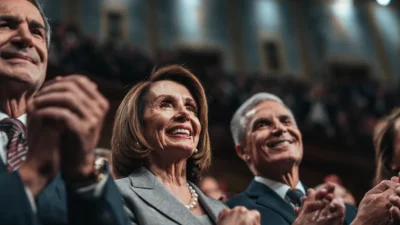TLDR
- Many of us thought all of crypto’s woes would dissipate after Trump signed his executive order.
- According to Caitlin Long, that’s not the case.
- Debanking is still an ongoing issue.
One of our team members took his show on the road to ETHDenver last week. He knows we’ve been keeping an eye on debanking problems with crypto companies. He sent us this video and asked us to write up a report.
Custodia Bank’s Caitlin Long, a known advocate for crypto-friendly banking, pulled no punches when addressing the lack of progress on crypto debanking. Speaking at ETHDenver on Feb. 28, Long criticized the U.S. government for its unchanged stance on crypto’s place in the banking system.
If you’re a blockchain beginner or eyeing crypto cautiously, here’s what you need to know about debanking, its implications, and why this conversation is heating up again.
“Nothing Has Changed”
According to Long, despite perceptions that the U.S. government has softened its stance on crypto, the reality tells another story. Long told her ETHDenver audience that federal banking agencies haven’t reversed any of the anti-crypto guidance that’s been in place for years. Banks are still largely discouraged from engaging with digital assets, even minimally.
“It is still presumed unsafe and unsound for a bank to touch a digital asset even in a de minimis amount,” she said, pointing out that this regulatory inertia continues to stifle crypto innovation in banking.
The root of the problem, she claims, lies in long-term leadership opposing change. Martin Gruenberg, who served as chair of the Federal Deposit Insurance Corporation (FDIC) for 15 years, has faced criticism for his resistance to technological evolution in banking.
According to Long, this resistance has left the American banking system struggling to adapt to current demands. While Gruenberg was replaced in January by Acting Chair Travis Hill, Long argues that leadership alone won’t resolve the ongoing regulatory gridlock.
The Shadow of Operation Chokepoint 2.0
The term “Operation Chokepoint 2.0” is a label some use to describe an alleged federal effort aimed at debanking crypto companies. Long believes Gruenberg played a role in pushing this agenda, further complicating banks’ ability to handle crypto assets.
For new crypto users, debanking isn’t just a regulatory headache for banks — it’s a roadblock for all of us. Fewer partnerships between the crypto and banking worlds could mean limited access to crypto-friendly financial services.
Translation? It could directly impact how easily you buy, sell, or store digital assets.
The SEC and a “Massive 180”
While the banking sector remains stuck in the past, Caitlin Long acknowledged a surprising twist on the regulatory front.
The Securities and Exchange Commission (SEC) has recently performed what she calls a “massive 180” in its approach to crypto. The change has been led in part by Hester Peirce, who is spearheading the SEC’s new Crypto Task Force.
One notable example is the cancellation of Staff Accounting Bulletin 121, a contentious rule that would’ve required financial firms holding crypto to report these holdings as liabilities. This move is a step towards improved clarity and fairness in crypto transaction accounting.
However, Long is quick to point out that progress by the SEC doesn’t solve the overarching problem. Clear banking regulations are still lagging behind these changes, leaving crypto businesses and users alike in limbo.
Stablecoins and the Push for Cash Reserves
Stablecoins — the pegged digital assets designed to maintain a consistent value — also entered Long’s conversation. Long believes stablecoin issuers need stricter consumer protections, especially when it comes to holding sufficient cash reserves.
Why does this matter to users? Think of stablecoins as the steady bridge between traditional finance and cryptocurrencies. Without solid financial backing, the whole thing could collapse without warning, dragging unsuspecting users into the fallout.
Long highlighted the recent collapse of Silvergate Bank, pointing to its reliance on unstable business models. She warned that the U.S. banking system as a whole isn’t faring much better. According to her, the average U.S. bank holds only eight cents in cash per dollar of demand deposits, making it fundamentally susceptible to bank runs.
“In the crypto industry, I think we’ve learned that that business model does not work,” Long said, arguing that stablecoins have the potential to survive only if regulators enforce stricter cash-backing requirements.
Dypto’s Two Pennies
Caitlin is right. As far as we can tell, he really hasn’t done anything to solve the debanking problem after the President’s executive order. But everything involving the government and politics takes time.
Rome wasn’t built in a day, right?
Love Trump or hate him, he gets things done that he says he’s going to get done. But sometimes, it may take him a while. He’s old, guys.
We think there is massive change on the way as far as banking and crypto are concerned. But it’s going to take some time. The President is dealing with Ukraine and running a country. The US is about more than crypto. There are 350 million people and he’s one man. Let’s give him time.
For now, crypto debanking continues to complicate the cryptocurrency industry’s relationship with traditional finance. While Caitlin Long’s critiques highlight the challenges, they also serve as a call to action.
So many people (including us) thought all of crypto’s problems would simply wash away after the executive order. They haven’t. It was a wake-up call. There is still work to be done.
Whether it’s through the evolution of stablecoins, relaxed banking restrictions, or a clearer regulatory landscape, these changes could pave the way for the inclusive, decentralized financial system that crypto promises.












